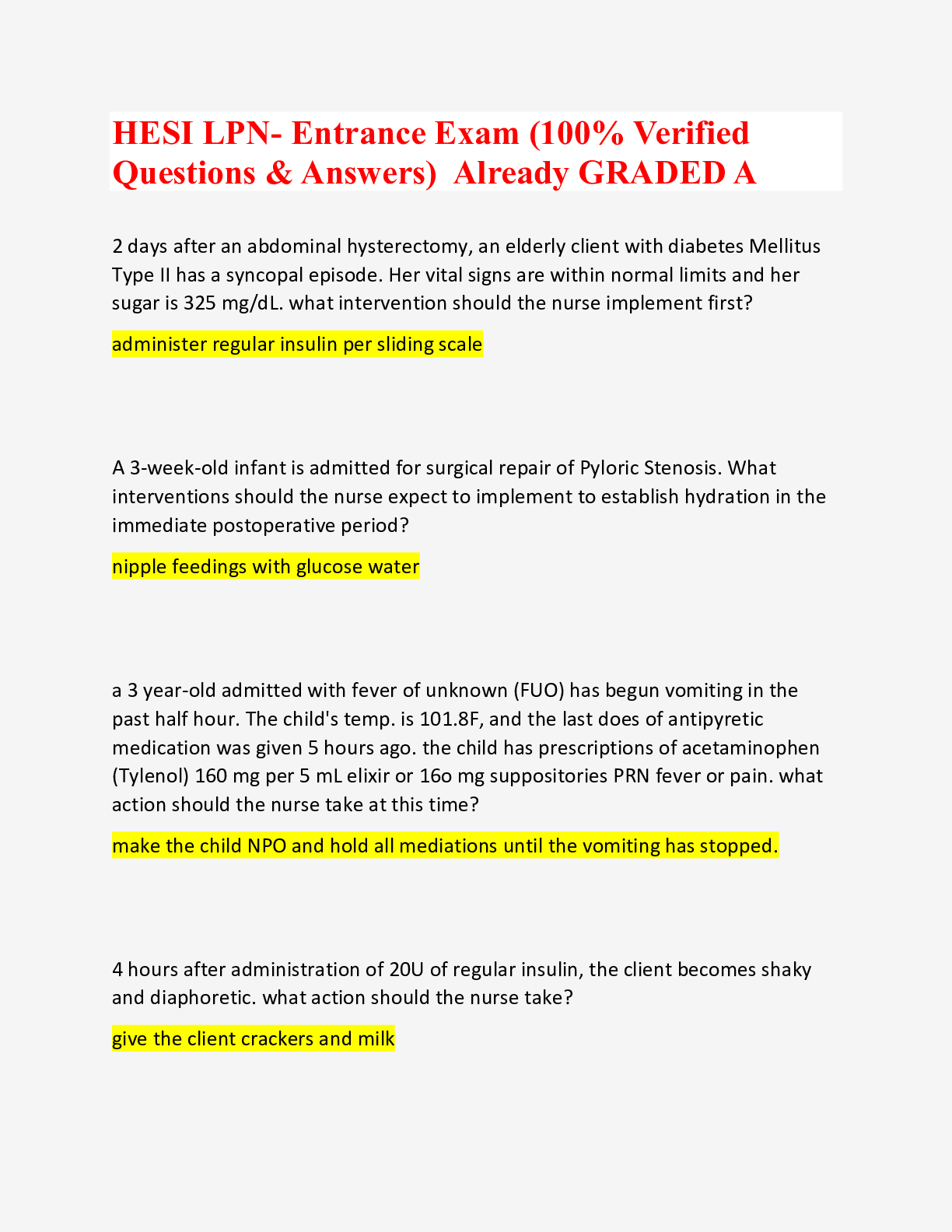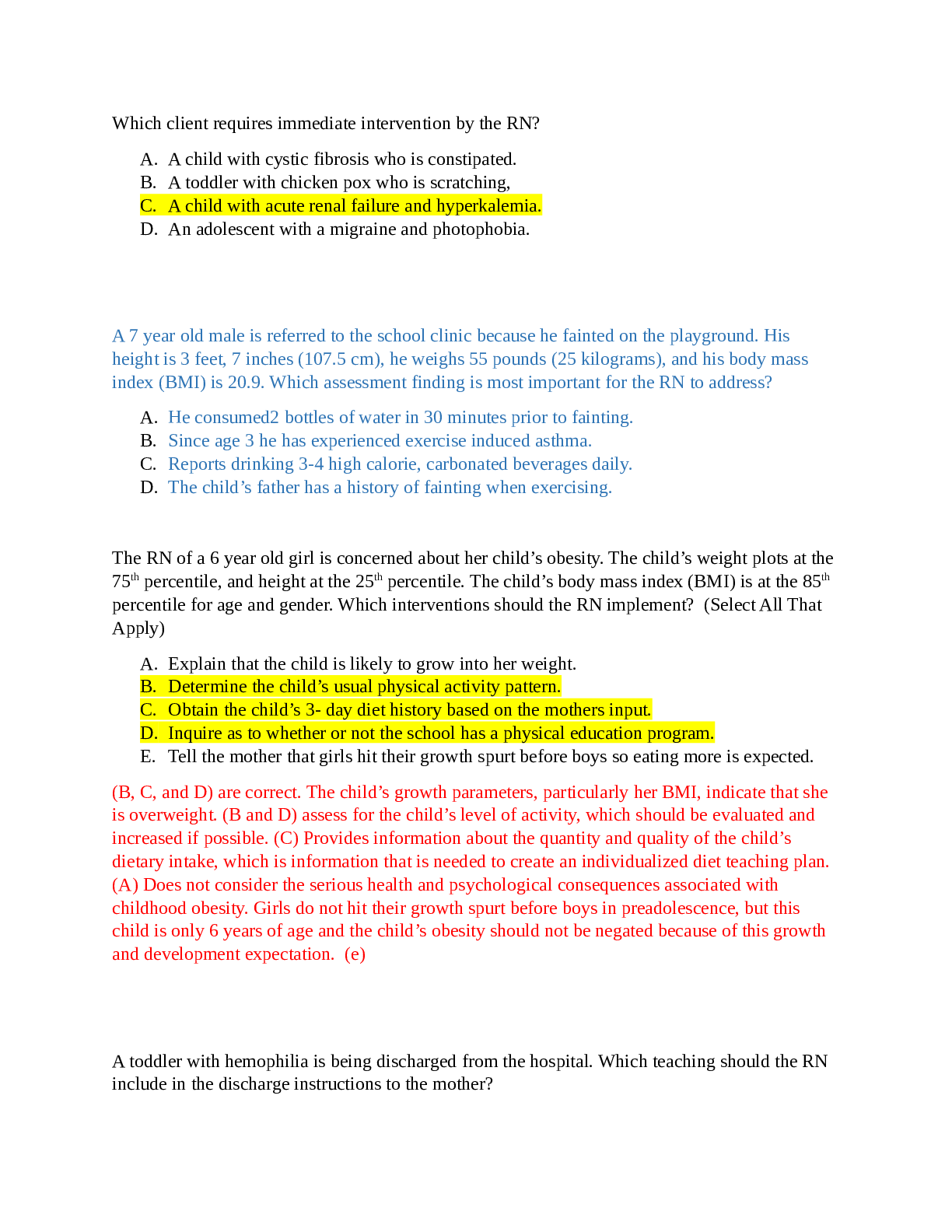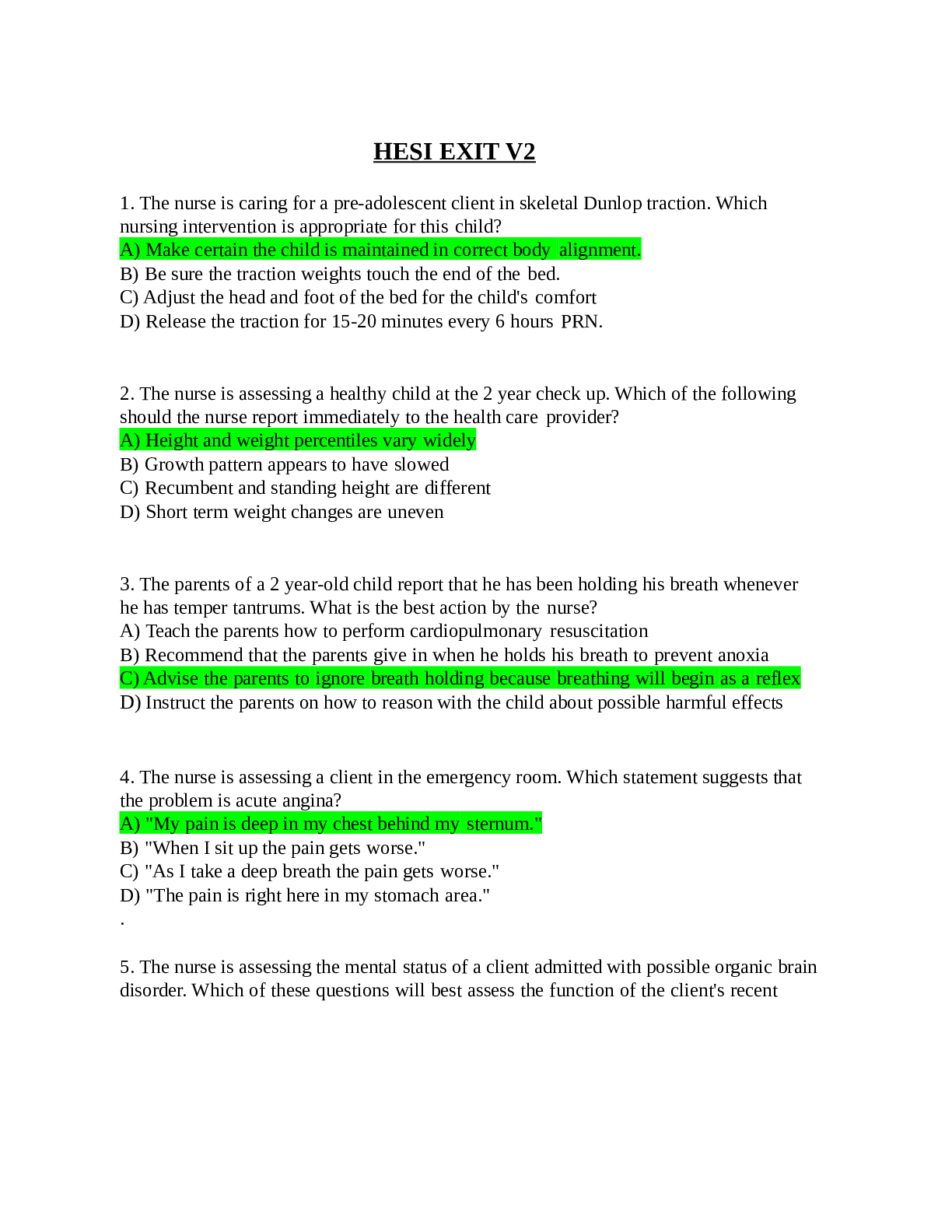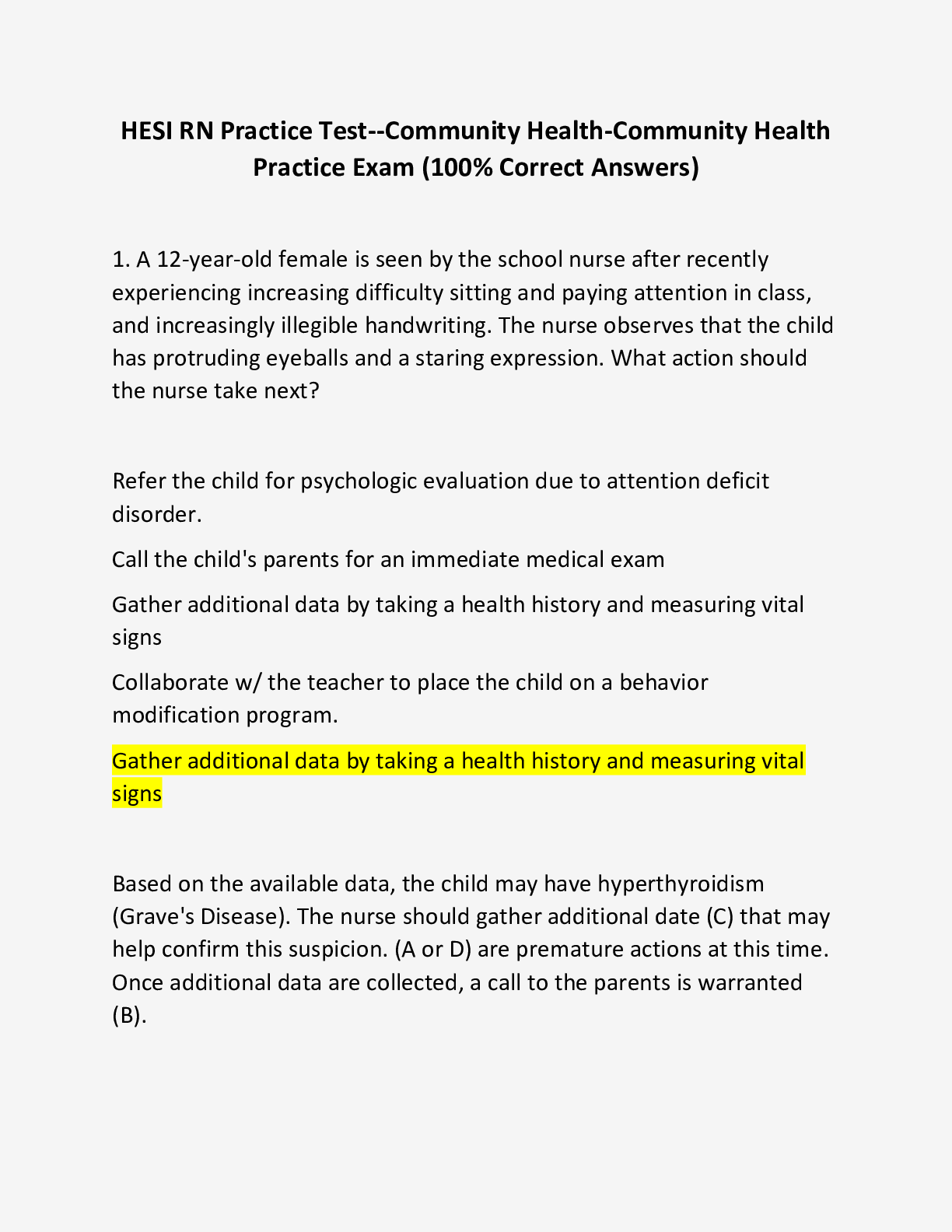HESI Fundamentals Exam (100% correct answers)
Document Content and Description Below
HESI Fundamentals Exam 1. A policy requiring the removal of acrylic nails by all nursing personnel was implemented 6 months ago. Which assessment measure best determines if the intended outcome of th... e policy is being achieved. a. Number of staff induced injury b. Client satisfaction survey c. Health care-associated infection rate. d. Rate of needle-stick injuries by nurse. 2. The nurse is preparing to assist a newly admitted client with personal hygiene measures. The client...the client’s gag reflex. Which action should the nurse include? A. Offer smalls sips of water through a straw B. Place tongue blade on back half of tongue C. Use a penlight to observe back of oral cavity D. Auscultate breath sounds after client swallows 3. The nurse explains to an older adult male the procedure for collecting a 24-hour urine specimen for creatinine clearance. A. Assess the client for confusion and reteach the procedure B. Check the urine for color and texture C. Empty the urinal contents into the 24-hour collection container D. Discard the contents of the urinal 4. A 54-year-old male client and his wife were informed this morning that he has terminal cancer. Which nursing intervention is likely to be most A. Ask her how she would like to participate in the client’s care B. Provide the wife with information about hospice C. Encourage the wife to visit after painful treatments are completed D. Refer her to support group for family members of those dying of cancer 5. A client who has a body mass index (BMI) of 30 is requesting information on the initial approach to a weight loss plan. Which action should the nurse recommend? A. Plan low carbohydrate and high protein meals B. Engage in strenuous activity for an hour daily C. Keep a record of food and drinks consumed daily D. Participated in a group exercise class 3 times a week 6. The nurse assesses a client who has a nasal cannula delivering oxygen at 2 L/min. To assess for skin damage related to the cannula, which areas should the nurse observe? A. Tops of the ear B. Bridge of the nose C. Around the nostrils D. Over the cheeks E. Across the forehead 7. The nurse observes an unlicensed assistive personnel (UAP) who is providing a total bed bath for a confused and lethargic client. The UAP is soaking the client’s foot in a basin of warm water placed on the bed. What action should the nurse take? a. Remove the basin of water from the client’s bed immediately b. Remind the UAP to dry between the client’s toes completely c. Advise the UAP that this procedure is damaging to the skin d. Add skin cream to the basin of water while the foot is soaking 8. The nurse in the emergency department observes a colleague viewing the electronic health record (EHR) of a client who holds an elected position in the community. The client is not a part of the colleague’s assignment. Which action should the nurse implement? a. Communicate the colleague’s actions to the unit charge nurse b. Send an email to facility administration reporting the action c. Write an anonymous complaint to a professional website d. Post a comment about the action on a staff discussion board 9. At 0100 on a male client’s second postoperative night, the client states he is unstable to sleep and plans to read until feeling sleepy. What action should the nurse implement? a. Leave the room and close the door to the client’s room b. Assess the appearance of the client’s surgical dressing c. Bring the client a prescribed PRN sedative-hypnotic d. Discuss symptoms of sleep deprivation with the client 10. The nursing staff in the cardiovascular intensive care unit are creating a continuous quality improvement project on social media that addresses coronary artery disease (CAD). Which action should the nurse implement to protect client privacy? a. Remove identifying information of the clients who participated b. Recall that authored content may be legally discoverable c. Share material from credible, peer reviewed sources only d. Respect all copyright laws when adding website content 11. A male client with unstable angina needs a cardiac catheterization, so the healthcare provider explains the risks and benefits of the procedure, and then leaves to set up for the procedure. When the nurse presents the consent form for signature, the client hesitates and asks how the wires will keep his heart going. Which action should the nurse take? a. Answer the client’s specific questions with a short understandable explanation b. Postpone the procedure until the client understands the risks and benefits c. Call the client’s next of kin and ask them to provide verbal consent d. Page the healthcare provider to return and provide additional explanation 12. The nurse is teaching a client how to do active range of motion (ROM) exercises. To exercise the hinge joints, which action should the nurse instruct the client to perform? a. Tilt the pelvis forwards and backwards b. bend the arm by flexing the ulnar to the humerus c. Turn the head to the right and left d. Extend the arm at the ide and rotate in circles 1) A client who is in hospice care complains of increasing amounts of pain. The healthcare provider prescribes an analgesic every four hours as needed. Which action should the LPN/LVN implement? A. Give an around-the-clock schedule for administration of analgesics. B. Administer analgesic medication as needed when the pain is severe. C. Provide medication to keep the client sedated and unaware of stimuli. D. Offer a medication-free period so that the client can do daily activities. Correct Answer: A 2) When assessing a client with wrist restraints, the nurse observes that the fingers on the right hand are blue. What action should the LPN implement first? A. Loosen the right wrist restraint. B. Apply a pulse oximeter to the right hand. C. Compare hand color bilaterally. D. Palpate the right radial pulse. Correct Answer: A 3) The LPN/LVN is assessing the nutritional status of several clients. Which client has the greatest nutritional need for additional intake of protein? A. A college-age track runner with a sprained ankle. B. A lactating woman nursing her 3-day-old infant. C. A school-aged child with Type 2 diabetes. D. An elderly man being treated for a peptic ulcer. Correct Answer: B 4) A client is in the radiology department at 0900 when the prescription levofloxacin (Levaquin) 500 mg IV q24h is scheduled to be administered. The client returns to the unit at 1300. What is the best intervention for the LPN/LVN to implement? A. Contact the healthcare provider and complete a medication variance form. B. Administer the Levaquin at 1300 and resume the 0900 schedule in the morning. C. Notify the charge nurse and complete an incident report to explain the missed dose. D. Give the missed dose at 1300 and change the schedule to administer daily at 1300. Correct Answer: D 5) While instructing a male client's wife in the performance of passive range- of-motion exercises to his contracted shoulder, the nurse observes that she is holding his arm above and below the elbow. What nursing action should the LPN/LVN implement? A. Acknowledge that she is supporting the arm correctly. B. Encourage her to keep the joint covered to maintain warmth. C. Reinforce the need to grip directly under the joint for better support. D. Instruct her to grip directly over the joint for better motion. Correct Answer: A 6) What is the most important reason for starting intravenous infusions in the upper extremities rather than the lower extremities of adults? A. It is more difficult to find a superficial vein in the feet and ankles. B. A decreased flow rate could result in the formation of a thrombosis. C. A cannulated extremity is more difficult to move when the leg or foot is used. D. Veins are located deep in the feet and ankles, resulting in a more painful procedure. Correct Answer: B 7) The LPN observes an unlicensed assistive personnel (UAP) taking a client's blood pressure with a cuff that is too small, but the blood pressure reading obtained is within the client's usual range. What action is most important for the nurse to implement? A. Tell the UAP to use a larger cuff at the next scheduled assessment. B. Reassess the client's blood pressure using a larger cuff. C. Have the unit educator review this procedure with the UAPs. D. Teach the UAP the correct technique for assessing blood pressure. Correct Answer: B [Show More]
Last updated: 2 years ago
Preview 1 out of 6 pages

Buy this document to get the full access instantly
Instant Download Access after purchase
Buy NowInstant download
We Accept:

Reviews( 0 )
$12.00
Can't find what you want? Try our AI powered Search
Document information
Connected school, study & course
About the document
Uploaded On
Dec 08, 2022
Number of pages
6
Written in
Additional information
This document has been written for:
Uploaded
Dec 08, 2022
Downloads
0
Views
132



.png)




.png)





